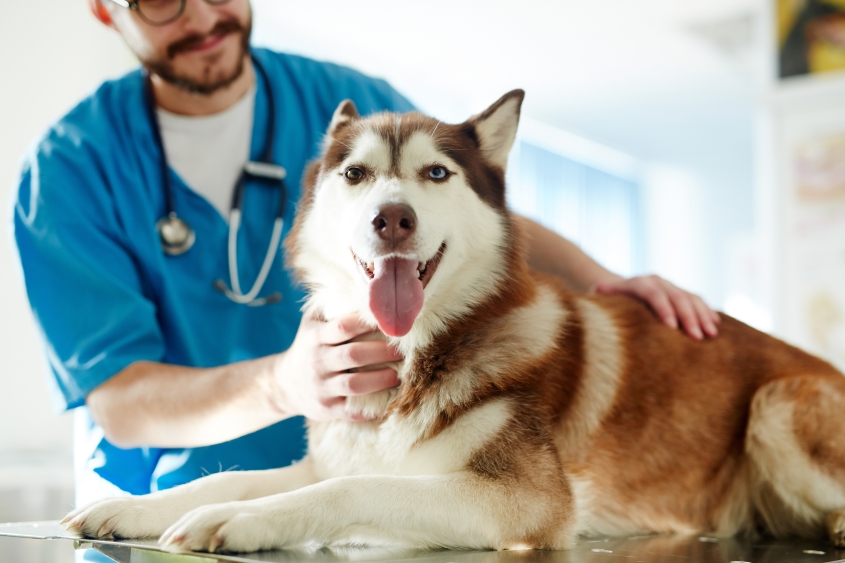How to make veterinary visits less stressful for dogs
Overview
For many dogs, a visit to the veterinary hospital can be a stressful and overwhelming experience. The unfamiliar sounds and smells, new people, other dogs, and the handling that comes with exams can make a trip to the vet frightening. However, with some preparation, these veterinary visits can become less stressful for our dogs.
Selecting your veterinary team
When choosing a veterinary team or considering a new veterinarian, consider inquiring about their approach to minimizing fear and stress during appointments. Many veterinarians and staff members are trained in programs such as Fear Free® and Low Stress Handling®, which aim to create a behavior-friendly environment using minimal restraint. These practices focus on making a behavior-friendly atmosphere and using minimal restraint methods since many dogs do better with less restraint for physical exams, vaccinations and blood draws. Often, these clinics will attempt to limit noise that could stress out pets, play calming music, examine dogs on the floor, where they feel less stressed, instead of on an exam table and more.
“Happy visits”
A "happy visit" refers to taking your dog to the vet on a day when they do not need medical treatment—just a visit to the building to create positive associations before or between scheduled appointments. The best time to start this process is during puppyhood, but it is equally beneficial for adult dogs.
Start with small steps, such as giving your dog treats in the car or parking lot outside the veterinary hospital. Call ahead to ensure the clinic isn't too busy, and ask if a staff member can greet your dog with treats outside. Gradually, work toward bringing your dog inside the building to continue rewarding them with treats. Moving at your dog’s pace helps reinforce that positive experiences occur when they visit the veterinary clinic.
Practice at home
Dog guardians can practice similar handling techniques commonly used by veterinarians and groomers at home. The goal is for dogs to learn to be comfortable with this type of handling in a stress-free environment. Practice handling your dog’s paws, ears, mouth and other body parts while offering treats as rewards. Puppyhood is the ideal time to teach comfort with handling, but dogs can learn at any age.
Never force your dog to accept touch or handling—always allow them to walk away if they are uncomfortable or unwilling to participate. If they walk away, it is information that the training needs to be in smaller, slower steps before progressing. If you’re unsure how to begin, speak with your veterinarian or a qualified trainer who uses humane practices. In some cases, working with a veterinary behaviorist may provide additional support to help address your dog’s fear, anxiety and stress.
A basket muzzle is a helpful tool for introducing and training your dog to be comfortable wearing. These humane tools can facilitate less handling and restraint, which often minimizes fear and creates more safety for everyone handling your pet. When appropriately introduced, your dog will associate the basket muzzle with food and good things instead of a scary experience.
Come prepared
On the day of your veterinary visit, bring your dog’s favorite treats from home. Opt for small, soft treats that can be broken into smaller pieces and given throughout the appointment. You might also consider bringing a frozen rubber, hollow treat dispenser (e.g., Kong dispenser), or a flat rubber textured mat (e.g., LickiMat) filled with your dog's favorite spreadable snacks for extra distraction. Enjoying tasty treats can help form a more positive association. If your dog stops eating or refuses treats, it often indicates their stress levels are too high, and you and your veterinary care team may need to make adjustments in their experience.
Anti-anxiety medications
For many dogs with pre-existing fear or anxiety, anti-anxiety medications can be beneficial when given at home a few hours before a veterinary visit. Not only can high levels of fear and stress in your dog negatively affect their overall health, but it often hinders your veterinarian’s ability to conduct a proper examination and provide medical care.
A dog’s welfare and behavior can significantly improve by giving anti-anxiety medications before stressful events. Speak to your veterinarian if you think anti-anxiety medication may benefit your dog before their next visit.
Control the controllable
Waiting rooms can increase stress due to the array of sounds, sights and smells. While you may not have control over the wait time, especially during emergency visits, you can minimize your dog’s anxiety by waiting in a quieter area, such as outside or in the car, if this is a less stressful environment for them.
Be your dog’s advocate
Sometimes, scheduled procedures cannot be completed that day if your dog’s fear and stress escalate during the visit. If the procedure is medically necessary, advocate for alternative methods, such as sedation, to ensure your dog’s comfort during the procedure.
Updated Dec. 2024




